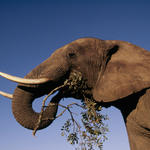Elephants are the largest land mammals on earth and have distinctly massive bodies, large ears, and long trunks. They use their trunks to pick up objects, trumpet warnings, greet other elephants, or suck up water for drinking or bathing, among other uses. Both male and female African elephants grow tusks and each individual can either be left- or right-tusked, and the one they use more is usually smaller because of wear and tear. Elephant tusks serve many purposes. These extended teeth can be used to protect the elephant's trunk, lift and move objects, gather food, and strip bark from trees. They can also be used for defense. During times of drought, elephants even use their tusks to dig holes to find water underground.
The African elephant is the largest of all elephant species and weighs up to eight tons. Two genetically different African subspecies exist: the savanna and the forest elephant, with a number of characteristics that differentiate them both.
Asian elephants differ in several ways from their African relatives, with more than 10 distinct physical differences between them. For example, Asian elephants are smaller than their African cousins, and their ears are smaller compared to the large fan-shaped ears of the African species. Only some male Asian elephants have tusks, while both male and female African elephants grow tusks.
Led by a matriarch, elephants are organized into complex social structures of females and calves, while male elephants tend to live in isolation or in small bachelor groups. A single calf is born to a female once every four to five years and after a gestation period of 22 months—the longest of any mammal. Calves are cared for by the entire herd of related females. Female calves may stay with their maternal herd for the rest of their lives, while males leave the herd as they reach puberty.
Elephants need extensive land areas to survive and meet their ecological needs, which includes food, water, and space. On average, an elephant can feed up to 18 hours and consume hundreds of pounds of plant matter in a single day. As a result, as they lose habitat, they often come into conflict with people in competition for resources.
Two years after China bans elephant ivory trade, demand for elephant ivory is down
Two years ago this month, China took the monumental step of banning elephant ivory trade within the country. Dec. 31, 2017 was the last day it was legal to buy or sell ivory there.
 © James Suter / Black Bean Productions / WWF-US
© James Suter / Black Bean Productions / WWF-USTHE ELEPHANT FAMILY
THREATS
 © WWF-Canon / Folke Wulf
© WWF-Canon / Folke Wulf
African elephant populations have fallen from an estimated 12 million a century ago to some 400,000. In recent years, at least 20,000 elephants have been killed in Africa each year for their tusks. African forest elephants have been the worst hit. Their populations declined by 62% between 2002-2011 and they have lost 30% of their geographical range, with African savanna elephants declining by 30% between 2007-2014. This dramatic decline has continued and even accelerated with cumulative losses of up to 90% in some landscapes between 2011 and 2015. Today, the greatest threat to African elephants is wildlife crime, primarily poaching for the illegal ivory trade, while the greatest threat to Asian elephants is habitat loss, which results in human-elephant conflict. WWF has advocated for an end to commercial elephant ivory sales in the US and other major markets like China, Thailand, and Hong Kong as the most effective and efficient solution to end this illegal ivory trade.
HABITAT LOSS
Elephants are also losing their habitats and ancient migratory routes due to expanding human settlements into their habitat, agricultural development, and the construction of infrastructure such as roads, canals, and fences that fragment their habitat. As a result, human-elephant conflict is rising as more and more elephants come into close contact with humans. This often leads to elephants destroying crops and property, as well as occasional human casualties. These negative interactions can result in the retaliatory killing of elephants.
ILLEGAL IVORY TRADE
In 1989, the Convention on International Trade in Endangered Species of Wild Fauna and Flora (CITES)—a global agreement among governments to regulate or ban international trade in species under threat—banned the international commercial trade in elephant ivory. Poaching rates dropped following the action, but began to surge again around 2010, due to renewed consumer interest in purchasing elephant ivory, largely in Asia. After campaigns by WWF and other conservation groups, governments in problematic ivory markets like Hong Kong, Thailand, the US and the UK were pushed to take action to clamp down on illegal and unregulated domestic trade that was fueling the poaching.
The real game changer is China—by far the largest market for elephant ivory—which banned domestic trade of elephant ivory as of January 1, 2018. Since then, Chinese consumer desire for elephant ivory has dropped and wholesale prices of elephant ivory, even on the black market, have declined. WWF has been working since to reduce consumer demand for elephant ivory and ensure the ban is effectively enforced.
WHAT WWF IS DOING
RESEARCH AND MONITORING
WWF helps establish new protected areas within elephant ranges and improve management effectiveness within existing protected areas. We support efforts to determine the population status of elephants in sites across Africa and Asia to make our conservation projects more effective. The results of surveys undertaken by the Monitoring the Illegal Killing of Elephants (MIKE) program—an international collaboration that measures the levels, trends, and causes of elephant mortality—provide important crucial information on elephant strongholds and poaching hotspots, thereby forming a base to support international decision-making related to conservation of elephants in Asia and Africa.
SIGNS OF HOPE
Unlike their Asian and African elephant counterparts in West and central Africa, as well as in a couple of Eastern African countries such as Tanzania and Mozambique, that all have experienced dramatic decreases in their populations, some major populations in Namibia, South Africa, and Zimbabwe have remained stable or are increasing.

REDUCING CONFLICT BETWEEN PEOPLE AND ELEPHANTS

Human-elephant conflict leads not only to negative interactions and loss of income, property, and lives, but also reduces community tolerance for conserving elephants. Addressing complex issues like human-wildlife conflict requires approaches that not only reduce the immediate impacts of negative interactions but also addresses the drivers and root causes of the conflict. WWF works with various stakeholders—particularly wildlife managers and communities—to incorporate tools and technologies, such as electric fencing, deterrents, and other tools, to prevent potentially harmful encounters. We also engage in efforts to educate communities that lead to behavior change that will minimize negative impacts. We help community response teams to respond to instances of human-elephant conflict and work with communities to develop alternative livelihood opportunities to help minimize economic impacts from crop loss. To reduce human-wildlife conflict in the long term, WWF works with governments and other stakeholders to address the root causes of human-elephant conflict, such as habitat loss and fragmentation and unplanned development.
STRENGTHENING ANTI-POACHING INITIATIVES
Community and government rangers and game guards help protect endangered species like elephants and WWF helps train and equip them. In the Kavango Zambezi Transfrontier Conservation Area (KAZA), the world's largest terrestrial conservation landscape, which harbors more than half of Africa's elephants, WWF aims to secure a future for these animals and other wildlife by supporting the work of the KAZA Secretariat and the five KAZA partner countries (Angola, Botswana, Namibia, Zambia, and Zimbabwe) and their local communities through better protection, increasing the knowledge of their seasonal movements, and promoting community-based conservation initiatives, in collaboration with the private sector. WWF trains rangers in elephant monitoring and antipoaching techniques and works with communities to manage and reduce conflict with elephants.
At the borders of Cambodia and Vietnam, WWF works with park staff to patrol protected areas and assess elephant distribution and numbers. In this transboundary landscape, WWF works to protect and enable movement of the elephant population, of which the population on the Vietnam side is significant and the largest remaining wild elephant population in the country.
STOPPING ILLEGAL IVORY TRADE
WWF works with TRAFFIC, the international wildlife trade monitoring network, to reduce the major threat that illegal and illicit domestic ivory markets pose to wild elephants. TRAFFIC also manages a global record of ivory seizures, called the Elephant Trade Information System (ETIS), that helps to identify routes and countries of particular importance in illegal trade.
REDUCING DEMAND FOR ELEPHANT IVORY
China's elephant ivory ban is a historic milestone in the ongoing effort to save an iconic species. But with China’s markets closed, markets elsewhere remain open and continue to attract consumers. And as more and more Chinese travel internationally—nearly 200 million Chinese tourists travel abroad each year—incidents of elephant ivory smuggling are on the rise. WWF is working directly with these countries to support the closing of their elephant ivory markets and leverage international policy and diplomacy channels. A big focus for WWF is also changing consumer behavior to reduce elephant ivory purchasing and create a new norm that elephant ivory is not socially acceptable. We are working with leading online retailers, social media platforms, tourism companies, and creative agencies. Strong partnerships are already in place with the travel and e-commerce sectors, with commitments to avoid promoting, handling, or selling elephant ivory. WWF is also working with a leading market research firm to conduct annual surveys of consumers to better understand consumer attitudes and desire for elephant ivory so that we can change social norms around ivory and reduce demand. Through this research, we are able to identify demographics of elephant ivory purchasers and consumers, understand their underlying motivations, and develop effective strategies to influence them.
PROTECTING ELEPHANT HABITAT
WWF works with elephant range state governments, local people, and non-governmental partners to secure a future for this keystone species by thinking beyond protected areas. Although significant elephant populations are now confined to well-protected areas, less than 20% of African elephant habitat is under formal protection. In Asia, on average, 70% of the wild elephant population lives outside protected areas. We advocate for large conservation landscapes like KAZA, which is located in southern Africa and is the largest terrestrial transboundary conservation area in the world. Home to around 225,000 elephants, we work to maintain this space to provide elephants freedom to roam.
PROJECTS
Wildlife Crime Technology Project
Over four and a half years, the Google.org-funded Wildlife Crime Technology Project (WCTP) provided WWF a platform to innovate and test a number of innovative technologies, many of which have the potential to change the course of the global fight against wildlife crime.Thirty Hills
WWF and partners secure protection for critical rain forest in Sumatra. Thirty Hills is one of the last places on Earth where elephants, tigers and orangutans coexist in the wild.
PUBLICATIONS
Demand Under the Ban: China Ivory Consumption Research 2019
Ivory Trade in Japan: A Comparative Analysis
China’s Ivory Market after the Ivory Trade Ban in 2018 from TRAFFIC

Factsheet: Demand under the Ban – China Ivory Consumption Research









.png)

 AFRICAN ELEPHANT
AFRICAN ELEPHANT ASIAN ELEPHANT
ASIAN ELEPHANT


 NILANGA JAYASINGHESenior Program Officer, Asian Species
NILANGA JAYASINGHESenior Program Officer, Asian Species GINETTE HEMLEYSenior Vice President , Wildlife Conservation
GINETTE HEMLEYSenior Vice President , Wildlife Conservation JAN VERTEFEUILLESenior Advisor, Advocacy, Wildlife Conservation
JAN VERTEFEUILLESenior Advisor, Advocacy, Wildlife Conservation




0 Comments:
Post a Comment